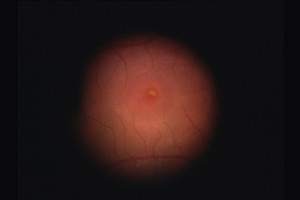Infectious keratitis in contact lens users and after LASIK
The article by Masters, Kocak and Waite(1) published in January´s issue of the Journal of Cataract and Refractive Surgery was very much needed and very much welcome. This article is a methaanalysis of the risk of corneal keratitis in different types of contact lenses and LASIK. Articles about contact lens infectious keratitis were included if an annualized incidence could be inferred with the data of the article, if the keratitis were classified according to the type of contact lens used and if each subcategory had at least 1000 instances....
read moreCataract surgery with a smartphone / tablet.
Cataract surgery performed with a smartphone as a microscope. Video presented at the ESCRS in 2016 in Copenhagen.
read moreMETALLIC PARTICLES AFTER PHACOMULSIFICATION
This picture was taken by Julian Tendero, Optometrist from Baviera Clinica in Albacete (Spain). It shows a metallic? foreign body after phacoemulsification. We have reviewed the subject and we here show a resume. Metallic pieces in the anterior chamber, usually attached to the iris, after phacoemulsification, are very common. The first publication I could find about it comes from Dunbar et al. in 1995 (Dunbar CM, Goble RR, Gregory DW, Church WC. Intraocular deposition of metallic fragments during phacoemulsification: possible causes and...
read moreWHAT HAPPENED WITH THIS PATIENT?/QUE PASÓ CON ESTE PACIENTE?
The patient recovered completely in 4 months, treated only with topical steroids and mydriatics. El paciente se recuperó completamente en 4 meses, tratado únicamente con esteroides tópicos y midriáticos. We leave here the discussion and conclusion of the following paper: Doyle E, Sahu D, Ong G. Solar retinopathy after the 1999 solar eclipse in East Sussex. Eye (2002) 16:203-206 They studied 15 patients who suffered solar retinopathy as a result of viewing the subtotal (98%) solar eclipse in East Sussex on 11th August 1999. DISCUSSION Eclipse...
read moreINTERMEDIATE VISION AFTER PRESBYOPIA CORRECTION
Presbyopia is an age-related eye condition where one of the signs is the reduction in the amplitude of accommodation, resulting in the loss of ability to change the eye’s focus from far to near. It is the most common age-related ailments affecting everyone around their mid- 40s. There were an estimated 1.272 billion cases of presbyopia worldwide in 2011. Of these, one-third of cases were among working-age people aged 40 or 45 years (depending on the age If all those people aged <65 years are assumed to be productive, the potential...
read moreWHICH PRESBYOPIA CORRECTION METHOD PROVIDES THE BEST INTERMEDIATE VISION
We have compared the intermediate vision obtained by five different presbyopia correction methods: lens exchange and implantation of Acri.LISA bifocal intraocular lens, lens exchange and implantation of ReSTOR +3 bifocal intraocular lens, lens exchange and implantation of ReSTOR +2,5 in the dominant eye and ReSTOR +3 in the non-dominant eye bifocal intraocular lenses, lens exchange and implantation of Finevision trifocal intraocular lens, and excimer laser vision correction leaving in the non-dominant eye a myopia of -1,5 diopters. The...
read moreMORE ABOUT DOUBLE-K: WHEN YOU DON´T HAVE PREOPERATIVE DATA
What about if we do not know the pre-laser K readings?. Should I still use double-K?. The answer is YES. How to do it…, there are two ways: 1- Use an standard K reading. In 5980 eyes seeking for refractive surgery in Clinica Baviera (Spain), the average K reading was 43,60. Other studies have reported slightly steeper K readings (Khabazkhoob M, Hashemi H, Yazdani K, Mehravaran S, Yekta A, Fotouhi A. Keratometry measurements, corneal astigmatism and irregularity in a normal population: the Teharan Eye Study. Ophthalmic Physiol Opt...
read moreDO I HAVE TO USE DOUBLE-K METHOD WHEN CALCULATING IOL POWER AFTER LASER REFRACTIVE SURGERY?.
DO I HAVE TO USE DOUBLE-K METHOD WHEN CALCULATING IOL POWER AFTER LASER REFRACTIVE SURGERY?. Double K method was describe by Dr Jaime Aramberri in 2003 (Intraocular lens power calculation after corneal refractive surgery: Double-K method. J Cataract Refract Surgery 2003, 29(11):2063-2068). The rationale for using double-K method is because most calculating formulae use keratometric power twice in their algorithms: First to calculate the power of the lens to be implanted in the vergence formula, that is the power the cornea has at the moment...
read moreHOW TO DETECT INTOLERANT PEOPLE TO MULTIFOCAL INTRAOCULAR LENSES
This is the defocus curve of a patient with a trifocal lens implanted one year ago. The result is excellent, however, the patient is unhappy…, the vision is not sharp. Could it be due to a decrease in contrast sensitivity?. It could be possible but not in this case. See the contrast sensitivity curve… So, what it is?…, how can we detect people who will not do well with a multifocal intraocular lens?. This is the key to the question, we will try to analyze in next posts.
read moreIS ASPHERIC LASER TREATMENT EFFECTIVE?
We many times wonder when planning a treatment if it is worthy to apply a personalized treatment to a patient. Is it worthy?. Is it cost-effective?. Laser manufacturers persuade us to use this kind of treatments. Many times we do not know how much effect they have in vision and even if it is true what they tell us they do. When using the platform Technolas Z 100P, we have the possibility of using the so called “aspheric treatment”. With this kind of treatment and when treating myopia or simple or compound myopic astigmatism, we...
read more






